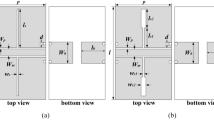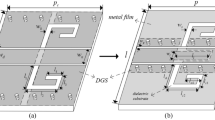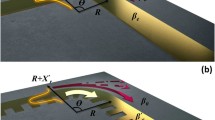Abstract
In this paper, a novel coplanar waveguide (CPW) spoof surface plasmon polariton (SSPP) transmission line (TL) is firstly proposed. The equivalent circuit model is established to analyze the effects of the folded stepped groove and spiral-shaped structure. The investigation based on the equivalent circuit model indicates that the dispersion curves can be easily controlled by changing the inductance brought by the etched grooves and spiral structure. The proposed SSPP has a lower cutoff frequency, stronger field confinement, and smaller system size. The proposed SSPP TL is designed, fabricated, and tested, providing experimental demonstration for the design and analysis. The measured S-parameters and electric field distributions indicate that the designed SSPP structure enhances the electric field confinement ability, while achieving miniaturization of SSPP TL.
Similar content being viewed by others
Avoid common mistakes on your manuscript.
Introduction
Surface plasmon polaritons (SPPs) are a special type of electromagnetic (EM) wave mode with strong field constraints [1]. According to Maxwell’s equations, SPPs are excited at the interface of two media with opposite dielectric constants, which can propagate along the interface but exhibit exponential decay in other directions [2]. SPPs exhibit excellent field confinement properties, and have garnered widespread attention in the fields of nanophotonics and plasmonics over the past few decades. However, in the lower terahertz, millimeter-wave, and microwave bands, the behavior of metals is that of a conductor rather than a plasmonic material, which limits the further development of SPP-based devices [3].
To apply the outstanding physical properties of SPPs into terahertz and microwave engineering, the concept of spoof SPPs (SSPPs) supported by periodic subwavelength structures was developed [4]. In 2004, the first SSPP was realized by a square metal hole array [5]. In SSPP structures, ultra-thin SSPP structures, also known as SSPP waveguides or SSPP transmission lines (TLs) [6, 7], have new advantages over traditional microwave media, such as low crosstalk [8], miniaturized packaging [9], and customizable dispersion [10]. In 2014, an ultrathin metal corrugated SSPP transmission line (TL) was proposed [11].
However, in the microwave and terahertz frequency bands, electromagnetic wave transmission lines are limited by wavelength. Through strong field confinement, the electromagnetic wave field can be localized to the sub-wavelength scale, achieving precise control over the sub-wavelength scale. In order to achieve strong field constraints, people have made a lot of efforts. In [12], the field confinement of SSPPs is controlled by proposing a glider-symmetric double-layer (D-L) spoof surface plasmon polariton (SSPP) structure. In [13], a novel planar SSPP waveguide with a fishbone corrugated groove structure is proposed to control the field constraints of SSPPs. Nevertheless, according to the working principle of typical SSPP TLs [14], if stronger field constraints are expected in the millimeter or sub-terahertz band, much larger spaces are required. In [15], although the SSPP TL adopts a miniaturized single-sided structure, to achieve a cutoff frequency below 700 GHz, a width larger than 40 µm is required. In conclusion, there exists a contradiction between achieving strong field confinement and miniaturizing the geometric dimensions of spoof SPP TLs, which may be a critical limitation in practical applications.
In [14], the plot of field distribution was observed, and based on the dispersion analysis of spoof SPPs, it was concluded that there is a negative correlation between the field constraint ability and the cutoff frequency. However, to our knowledge, there is currently no direct SSPP equivalent model proposed, which may greatly limit the further application of SSPPs.
In this paper, a novel SSPP TL developed from coplanar waveguide (CPW) is firstly proposed. In comparison to the conventional uniform slotted SSPP TL unit cells, the proposed SSPP TL in the paper adopts a folded stepped slot and a spiral-shaped strip. An equivalent circuit model is established to analyze the effects of the folded stepped slot and spiral-shaped strip. The investigation of the CPW SSPP based on the equivalent circuit model indicates that the dispersion curves can be easily controlled by modifying the inductance brought by the stepped slots and the spiral-shaped strips. This new type of CPW SSPP exhibits lower cutoff frequency, stronger field confinement capability, and smaller SSPP system size. A CPW-based SSPP structure is designed based on the methods derived from the model analysis to simultaneously achieve strong field confinement and miniaturization of the SSPP TL.
Theory and Design Principle
The conventional SSPP unit cell is shown in Fig. 1, where the metal film portion is represented in gray and the dielectric substrate portion is represented in white. The CPW waveguide shown has a line width of wma, a coupled gap of wpa, and a period of pa. Each groove structure consists of two strip-shape grooves with the length of lsa and the gap of wa, etched on both sides of the CPW grounds. The substrate in Fig. 1, and all the following examples in this paper, is FR4, with a thickness of 0.8 mm, a dielectric constant of 4.4, and a loss tangent of 0.02.
For the periodic structures, their electromagnetic characteristics can be described by their unit cells. The dispersion curve can be drawn from the scattering matrix calculated by the circuit model of the cell. In order to gain a deeper understanding of the mechanism of the proposed SSPP unit, we established equivalent circuit models for different unit cells using mixed distribution and lumped circuit components.
The equivalent circuit model of conventional SSPP unit is shown in Fig. 1. The transmission lines with impedance Z1 and electrical length θ1 represent the two CPW lines with a width of Wma and a length of pa/2. The two grooves are modeled by the two inductors of L. The two transformers in Fig. 1 describe the electromagnetic coupling between the CPW lines and the etched groove structure. The turn ratios of two transformers can be extracted using the method proposed in [16].
In the equivalent circuit model, the current and voltage are defined as the current flowing through a conductor and the potential difference between the conductor and ground, respectively. For the periodic structures, the relationship between the input (Vn, In) and output (Vn+1, In+1) can be calculated, namely the voltage and current of the unit cell. The voltage and current of the unit cell meet the following relationship.
where β is the propagation constant.
The transfer matrix, also known as the ABCD matrix, can be used to describe the input–output relationship between adjacent unit cells in a periodic structure.
Due to the symmetrical structure proposed in this article, the propagation constant β should satisfy the following relationship:
By utilizing the circuit parameters of the proposed equivalent circuit model, the ABCD matrix can be calculated as follows:
By combining Eqs. (1), (2), (3), and (4), the relationship between the inductance L and propagation constant β can be obtained as follows:
where ω is the angular frequency.
As seen from Eq. (5), the increase of L leads to the decrease of A, resulting in a larger β. In other words, the larger the L, the smaller the cutoff frequency of the dispersion curve, and also the better the field confinement.
To further reduce size occupancy and enhance field confinement capability, one way is to increase L by changing the width of the groove gap. In addition, using a spiral-shaped structure can also increase L. We propose the SSPP unit cell as shown in Fig. 2.
Unlike conventional SSPP TLs, the groove structure we proposed consists of a narrow groove and a wider groove, forming a folded stepped groove. The length of the narrow groove is ls, the gap is ws, the length of the wide groove is ps, and the width is wd. In addition, to further control the dispersion curve, metal through holes and spiral-shaped strip structure is used. The lengths of each part of the spiral-shaped strip from the outside to the inside are l1, l2, l3, and l4 and the widths are p1, p2, p3, p4, and p5, respectively. By utilizing these additional structures to form a CPW structure, better signal transmission and prevention of signal interference can be achieved, thereby improving the overall performance of the system.
Due to the additional inductance caused by changing the slot structure and adding a spiral-shaped strip, we update the equivalent model by adding two additional inductors with the value of ΔL as shown in Fig. 3.
In order to further verify the conclusion of Eq. (5), Fig. 2 preliminarily compares the electromagnetic simulated dispersion curves of SSPP unit cells under different total inductance values Ltotal, and analyzes the simulation results using the SSPP unit intrinsic mode solver in the commercial software CST Microwave Studio. Place the unit in the air box, set the boundary conditions in the x-axis direction as periodic boundaries, and set the y-axis and z-axis directions as ideal PEC boundaries. The dimension parameters in Fig. 2 are set as follows: ls = 9 mm, ws = 0.15 mm, ps = 7 mm, wd = 2 mm, l1 = 7 mm, l2 = 5.7 mm, l3 = 4.4 mm, l4 = 3.1 mm, p1 = 8 mm, p2 = 6.7 mm, p3 = 5.4 mm, p4 = 4.1 mm, p5 = 2.8 mm, wp = 0.15 mm, wm = 2.65 mm, l = 55 mm, p = 25 mm. In Fig. 4a, wd is set to be 2 mm and the four values of ws are 0.01 mm, 0.05 mm, 0.10 mm, and 0.15 mm. In Fig. 4b, ws is set to be 0.15 mm and the four values of wd are 0.3 mm, 1 mm, 2 mm, and 3 mm.
As shown in Fig. 4, the proposed SSPP exhibits a typical SPP response. The dispersion curve approaches the light line at lower frequencies, but gradually moves away at higher frequencies. As mentioned earlier, the larger the L, the lower the cutoff frequency, and the more obvious the SSPP response, resulting in stronger field constraints.
Another way to control the dispersion curve is to add a spiral-shaped strip structure. To investigate the influence of this structure, the EM simulation dispersion curves under different turns of spiral-shaped structure are compared in Fig. 5.
The total inductance values corresponding to the three spiral-shaped strip structures shown in Fig. 5 are 11.56 nH, 9.97 nH, and 8.06 nH, respectively. Obviously, the proposed SSPP corresponds to the structure A shown in Fig. 5. It can be seen from the figure that the larger the number of turns of the spiral-shaped strip, the larger the total equivalent inductance, the more obvious the SSPP response, and the stronger the field confinement is. The conclusion in the figure is consistent with that obtained from Eq. (5), which verifies the accuracy of the proposed model.
Therefore, as shown in Fig. 5, the proposed SSPP in this paper achieves flexible dispersion control by changing the folded stepped groove and spiral-shaped structure, and further reduces the circuit size to a certain extent, achieving stronger field constraints.
Fabrication and Measurement
Based on the cell dispersion characteristics analyzed above, corresponding SSPP TL with low-pass filtering characteristics is designed. The transverse width of SSPP TL is reduced by adopting a folded stepped groove and a spiral-shaped structure. The schematic configuration of the transmission line is shown in Fig. 6, which consists of three parts: (I) CPW serves as the input/output port connected to the SMA connector for measurement, (II) the transition area from CPW to SSPP waveguide is used for mode conversion, and (III) the SSPP structure has a periodic arrangement of nine units.
In order to further quantitatively evaluate the performance of SSPP waveguides, we made a prototype as shown in Fig. 7, with the same parameters as the configuration in Fig. 2. Figure 8 shows the comparison between simulated and measured S-parameters at the cutoff frequency. At low frequencies, the simulation results are in good agreement with the measured results, indicating that the proposed SSPP TL has excellent filtering characteristics consistent with the theoretical design, while occupying a relatively small volume. The difference between simulated and measured values is caused by factors such as manufacturing tolerances and measurement environment.
In addition, the proposed SSPP TL exhibits obvious filtering performance. To visualize the filtering performance of the proposed SSPP TL, the simulated electric field distributions of the SSPP TL are investigated in Fig. 9. It can be observed in Fig. 9 that in the pass frequency band the EM waves propagate smoothly along the TL, while in the reject frequency band, most of the waves are reflected.
In Table 1, we compared the proposed SSPP TL with some reported SSPP TLs in terms of asymptotic frequency fa, groove shape, lateral width wt, and period p. It is evident that the proposed SSPP TL has the narrowest lateral width, and the shortest p, insertion loss (IL), and return loss (RL). It is evident that the proposed SSPP TL has the narrowest lateral width, and the shortest p. In addition, by increasing the inductance brought by the bottom spiral-shaped structure, the size of the SSPP can be further reduced.
Conclusion
This article proposes a novel SSPP TL based on the folded stepped groove and spiral-shaped structure. Research based on equivalent circuit models shows that the proposed SSPP has a lower asymptotic frequency, a stronger field confinement ability, and a smaller system size. In addition, by changing the folded stepped groove and spiral-shaped structure, the dispersion curve can be flexibly controlled. Finally, based on the proposed structure, a CPW SSPP TL is designed, manufactured, and tested to validate our design theory. The measurement results indicate that the structure has low asymptotic frequency and low-pass filtering characteristics, which is conducive to promoting the development and application of SSPPs.
Data Availability
No datasets were generated or analysed during the current study.
References
Barnes WL, Dereux A, Ebbesen TW (2003) Surface plasmon subwavelength optics. Nature 424(6950):824–830. https://doi.org/10.1038/nature01937
Garcia-Vidal FJ, Martin-Moreno L, Pendry JB (2005) Surfaces with holes in them: new plasmonic metamaterials. J Opt A Pure Appl Opt 7(2):S97. https://doi.org/10.1088/1464-4258/7/2/013
Wei D, Li J, Yang J, Qi Y, Yang G (2018) Wide-scanning-angle leaky-wave array antenna based on microstrip SSPPs-TL. IEEE Antennas Wirel Propag Lett 17(8):1566–1570. https://doi.org/10.1109/LAWP.2018.2855178
Shen XP, Cui TJ (2013) Planar plasmonic metamaterial on a thin film with nearly zero thickness. Appl Phys Lett 102(21):211909. https://doi.org/10.1063/1.4808350
Williams CR, Andrews SR, Maier SA, Fernandez-Dominguez AI, Martin-Moreno L, Garcia-Vidal FJ (2008) Highly confined guiding of terahertz surface plasmon polaritons on structured metal surfaces. Nat Photonics 2(3):175–179. https://doi.org/10.1038/nphoton.2007.301
Kianinejad A, Chen ZN, Qiu C-W (2018) Full modeling, loss reduction, and mutual coupling control of spoof surface plasmon-based meander slow wave transmission lines. IEEE Trans Microw Theory Tech 66(8):3764–3772. https://doi.org/10.1109/TMTT.2018.2841857
Zhang HC, He PH, Tang WX, Luo Y, Cui TJ (2019) Planar spoof SPP transmission lines: applications in microwave circuits. IEEE Microwave Mag 20(11):73–91. https://doi.org/10.1109/MMM.2019.2935363
Gao X et al (2019) Crosstalk suppression based on mode mismatch between spoof SPP transmission line and microstrip. IEEE Transactions on Components, Packaging and Manufacturing Technology 9(11):2267–2275. https://doi.org/10.1109/TCPMT.2019.2931373
He PH, Zhang HC, Tang WX, Cui TJ (2018) Shielding spoof surface plasmon polariton transmission lines using dielectric box. IEEE Microw Wirel Compon Lett 28(12):1077–1079. https://doi.org/10.1109/LMWC.2018.2878968
He PH, Ren Y, Shao C, Zhang HC, Zhang LP, Cui TJ (2021) Suppressing high-power microwave pulses using spoof surface plasmon polariton mono-pulse antenna. IEEE Trans Antennas Propag 69(12):8069–8079. https://doi.org/10.1109/TAP.2021.3083836
Gao X, Cui TJ (2015) Spoof surface plasmon polaritons supported by ultrathin corrugated metal strip and their applications. Nanotechnol Rev 4(3):239–258. https://doi.org/10.1515/ntrev-2014-0032
Zu H-R, Wu B, Su T (2022) Beam manipulation of antenna with large frequency-scanning angle based on field confinement of spoof surface plasmon polaritons. IEEE Trans Antennas Propag 70(4):3022–3027. https://doi.org/10.1109/TAP.2021.3118739
Guo Y-J, Xu K-D, Cheng X, Deng X-J (2019) Review of some new spoof surface plasmon polariton waveguides. In: 2019 Photonics & Electromagnetics Research Symposium - Fall (PIERS - Fall). pp 2858–2864. https://doi.org/10.1109/PIERS-Fall48861.2019.9021711
He PH, Zhang HC, Gao XX, Niu LY, Tang WX et al (2019) A novel spoof surface plasmon polariton structure to reach ultra-strong field confinements. Opto-Electron Adv 2:190001. https://doi.org/10.29026/oea.2019.190001
Liang Y, Yu H, Wen J et al (2016) On-chip sub-terahertz surface plasmon polariton transmission lines with mode converter in CMOS. Sci Rep 6:30063. https://doi.org/10.1038/srep30063
Caloz C, Okabe H, Iwai T, Itoh T (2004) A simple and accurate model for microstrip structures with slotted ground plane. IEEE Microw Wirel Compon Lett 14(4):133–135. https://doi.org/10.1109/LMWC.2004.828725
Author information
Authors and Affiliations
Contributions
All authors contributed to the study conception and design. The first draft of the manuscript was written by Y.-X.C. and all authors commented on previous versions of the manuscript. J.-Y.Z. prepared Figs. 4, 5, and 9. Y.-Y.K. wrote the conclusion. G.-P.Z. assisted in the completion of manuscript revision. Methodology, review, and editing were performed by L. L. All authors read and approved the final manuscript.
Corresponding author
Ethics declarations
Competing Interests
The authors declare no competing interests.
Additional information
Publisher's Note
Springer Nature remains neutral with regard to jurisdictional claims in published maps and institutional affiliations.
Rights and permissions
Springer Nature or its licensor (e.g. a society or other partner) holds exclusive rights to this article under a publishing agreement with the author(s) or other rightsholder(s); author self-archiving of the accepted manuscript version of this article is solely governed by the terms of such publishing agreement and applicable law.
About this article
Cite this article
Cui, YX., Zhang, JY., Li, L. et al. Surface Plasmon Transmission Line Based on Folded Stepped Grooves and Spiral-Shaped Structures. Plasmonics (2024). https://doi.org/10.1007/s11468-024-02373-7
Received:
Accepted:
Published:
DOI: https://doi.org/10.1007/s11468-024-02373-7













